Heat in buildings strategy: business and regulatory impact assessment
This business and regulatory impact assessment (BRIA) accompanies our Heat in Buildings Strategy.
3. Context
3.1 Climate Change Targets
The Climate Change (Emission Reductions Targets) (Scotland) Act 2019 increases Scotland's ambition to reduce greenhouse gas emissions, including a target for net-zero emissions by 2045, and interim targets for reductions of 75% and 90% by 2030 and 2040 respectively. In response the Scottish Government updated its Climate Change Plan in December 2020,[4] setting out how the accelerated targets will be achieved. The Climate Change Plan update sets out emissions envelopes for the Buildings sector (covering both domestic and non-domestic buildings) as shown in Figure 1. Using a 2020 baseline, this represents a 68% reduction to 2030.

Sector-level emissions envelopes run to 2032. In order to achieve our economy-wide net-zero target, by 2045 all of our homes and buildings will need to significantly reduce their energy use and use a zero emissions heating system.
3.2 Heat supply and emissions across residential housing
Figure 2 shows that the vast majority of Scottish homes rely on fossil fuel boilers; 81% of Scottish homes use mains gas, 5% use heating oil, and a further 2% use LPG or solid mineral fuels.[5] Together these high carbon fuels account for an estimated 88% of the Scottish residential fuel mix, none of which are compatible with our net zero emissions ambition.
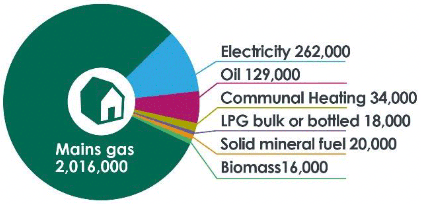
Source: Scottish House Condition Survey 2019
Only around 11% of households currently have a renewable or very low emissions heating system, such as a heat pump, biomass boiler or electric storage heating.[6]
The Energy Saving Trust estimate that over half of non-domestic properties already use low or zero emissions sources, mainly electrical However, the non-domestic stock varies significantly in size, and some of the largest non-domestic buildings are more likely to have mains gas systems.[7]
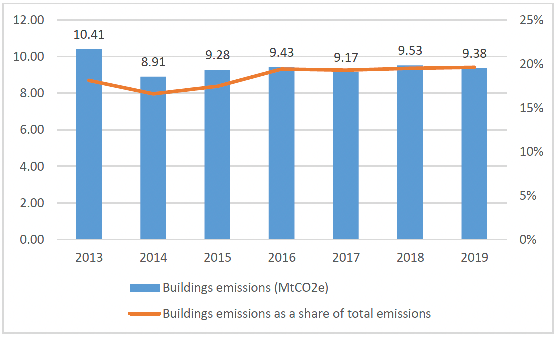
Source: Scottish Greenhouse Gas statistics[8]
Emissions from the Buildings sector have decreased from 10.41 MtCO2e in 2013 to 9.38 MtCO2e in 2019. Yet given reductions in emissions across other sectors of the economy, most notably power supply, the share of total emissions from the Buildings sector has increased slightly from 18.1% in 2013 to 19.6% in 2019.
To meet the interim statutory targets set out above, around 50% of homes, or over 1 million households, will need to convert to zero emissions heating systems by 2030. At the same time, we will need to convert the equivalent of 50,000 of Scotland's non-domestic properties to zero emissions sources of heat.[9]
Currently around 3,000 renewable heating systems are installed in Scotland's homes per year[10] (primarily heat pumps, with a smaller number of biomass and solar thermal installations). The Heat in Buildings Strategy sets out that to maintain progress towards our statutory emission reduction targets, zero emissions heat installations must scale up to provide a total of at least 124,000 systems installed between 2021 and 2026. The installation rate is expected to peak at over 200,000 new systems per annum in the late-2020s. This must be accompanied by significant demand reduction through improvements to energy efficiency and growth of blending green gas in the grid.
3.3 Fuel Poverty Targets
The Fuel Poverty (Targets, Definition and Strategy) (Scotland) Act 2019[11] requires that by 2040 no more than 5% and 1% of all households should suffer from fuel poverty and extreme fuel poverty respectively and that the median fuel poverty gap should be no more than £250 (adjusted for 2015 prices). These targets apply at local authority level as well as nationally.[12] In 2019, 24.6% of all households were living in fuel poverty, 12.4% were living in extreme fuel poverty and the median fuel poverty gap was £700 (adjusted for 2015 prices).
Poor energy efficiency is one of the four main drivers of fuel poverty, the others being low household income, high household energy prices and how energy is used in the home. Figure 4 shows that 40% of households living in the least energy efficient properties (rated EPC F or G) were in fuel poverty in 2019, compared with 20% of households in B/C-rated properties. We want our all homes to be as energy efficient as possible, meeting a minimum standard equivalent to EPC C, and hrough our delivery programs, we want to reach higher standards for households in fuel poverty, meeting a minimum standard equivalent to EPC B, in order that we can remove poor energy efficiency as a driver of fuel poverty.
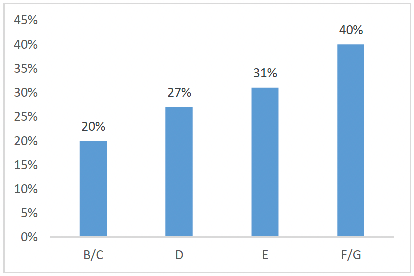
Source: Scottish House Condition Survey 2019[13]
3.4 Energy efficiency
As figure 5 shows, the energy efficiency of Scotland's homes is improving. Since 2010, the share of the most energy efficient dwellings (rated EPC C or better) has increased by 27 percentage points.[14] In 2019, 45%[15] of Scotland's homes were rated EPC C or better, with social housing generally more energy efficient (56% of homes having attained EPC C) than the private sector (41%).
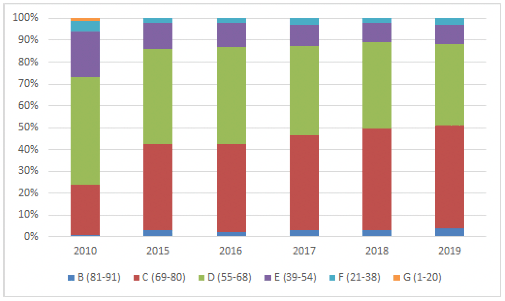
Source: Scottish House Condition Survey: 2019 Table 17.
Our non-domestic buildings are hugely diverse and analysis shows that almost three in four of all non-domestic premises have a current EPC rating of E or worse with only 5 percent rated B or better.[16] This varies significantly by building type, as shown in Figure 6.
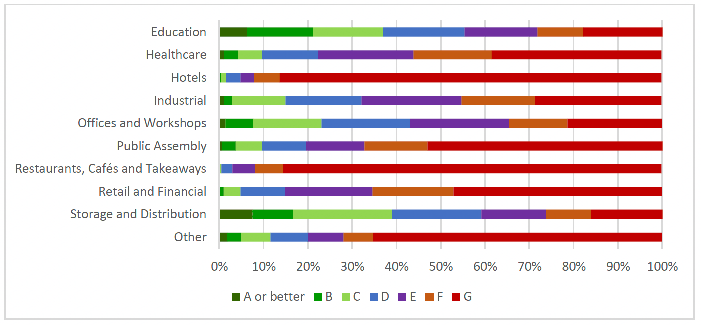
Source: Scotland's non-domestic energy efficiency baseline: report
More progress must be made across both residential and non-residential buildings. Reducing heat demand through fabric measures is key to minimising the operating costs of zero emissions heating systems, while also minimising the demand on the electricity grid.
Contact
Email: heatinbuildings@gov.scot
There is a problem
Thanks for your feedback